
Lance tip 13th-14
Giant crossbow bolt head, or early war lance tip. Excavated condition. Long, narrow rhomboid point. Edges cut with simple teeth. Socket retains some of the original wood. 12 inches long.

Ballock Dagger 14th century
Ballock Dagger. Found in the river Thames in London by Thames mudlarks. Single edged blade with whittle tang and simple wooden handle carved to form integral wooden hilt. Wood has been stabilized and fill added since recovery. Nigel Mills dated this dagger to the early 14th century.
Measurements: overall length 11 in. (28 cm), blade length 6.75 in. (17.1 cm), blade thickness at the hilt .284 in. (.7 cm), blade width at the hilt .9375 in. (2.4 cm), grip length butt to ballocks 3 in. (7.6 cm), width of ballock 2.24 in. (5.7 cm), weight 5.8 oz (164.4 g)

Dagger circa 1400
Dagger. Typically Swiss. Good, solid excavated item. Handle missing. Includes typical hilt of curved forms. Double edged flattened diamond blade with distal taper. Handle was most likely wood and secured by the surviving pins in the butt plate.
Measurements: overall length 12.625 in. (32 cm), blade length 8.187 in. (20.8 cm), blade width at the hilt 1.146 in. (2.9 cm), blade thickness at the hilt .226 in. (.57 cm), grip length 3.375 in. (8.57 cm), weight 3.8 oz (107.72 g).

Dagger circa 1400
Basilard Dagger. Hilt of typical 'I' form. Somewhat worn excavated item. Handle missing. Single edge distal taper on the blade. Single narrow fuller on one side of the blade that extends 3/4 of the length of the blade. The fuller is .187 in. from the spine. Oringinal handle would have been formed of 2 sandwich scales secured by pins. Scales missing, several pins remain. The handle is hollow on one side.
Measurements: overall length 16.18 in (41 cm), blade length 11.18 in. (28.4 cm), blade thickness at the hilt .312 in. (.8 cm), blade width at the hilt 1.1875 in. (3 cm), hilt width 3.59 in. (9.1 cm), pommel width 3.24 in. (8.2 cm), weight 9.0 oz (255.14 g).

Rondel Dagger circa 1420
Stiff diamond shaped blade tapering to a point. With characteristic round guard and pommel. Smaller guard and larger pommel. Excavated but retaining most of its original form. Conserved. Purportedly found in Calais.
Measurements: overall length 11 3/8 inches, handle 3 3/8 inches, rear disk 2 1/4 inches across, hilt disk 1 1/2 inches across. Blade at the hilt 1 inch wide and .32 inch thick.

Ballock Dagger late 15th century
Excavated. Sharply tapered, deeply hollow ground, wedge shaped blade. Handle of typical form with a pair of lobes at the hilt and flairing out toward the pommel. The hilt with an iron plate bending down to form points on each side of the blade. Pommel with a disk shaped plate and a small copper washer and the peinned end of the tang. Wood with some modern fill. Measurements: 8 1/4 in (21 cm) blade. Ex. Coll. Anthony De Reuck.

Lance tip circa 1480
German Rennen (joust of war) lance head. From the Bidermann collection in Stuttgart
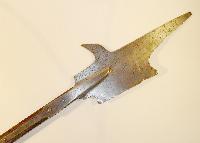
German or Swiss Halbard circa 1480-1500
Long, straight blade, wide mostly flat point and strong rear hook. Struck on both sides with an orb. 2 long, well formed straps. Complete with half of the original shaft. Formerly in the Marzoli collection.

Ballock Dagger 15th century
Excavated. Condition indicates a water find. Wooden handle with integral wooden guard. Studs (probably for the attachment of inset bands now lost) and inlaid silver. Blade of flattened diamond form. Illustrated in Laking 'European Armour and Arms' vol. 3 page 35 fig. 804 (described as ' of the Flemish type with silver enrichments which was recovered some years ago fom the Rhine.' and dated to 1470), Dean 'A Catalog of a Load Exhibition of Arms and Armor', Met. Museum of Art, 1911, No. 144. Formerly in the Keasbey collection. Sold as lot 184 of the Dec. 6, 1924 sale of the collection of Henry Griffith Keasbey held at the American Art Galleries by auctioneers Parke and Bernet where it is described as 'German c. 1400 found in the Rhine'. Also published in the "Metropolitan Museum of Art Catalog of European Daggers" by Bashford Dean, 1929 on page 52, number 35, listed with inventory number 28.74.6 attributed as a gift of George D. Pratt.
Measurements: overall length 10.25 in. (26 cm), blade length 5.625 in. (14.3 cm), hilt width 2.241 in. (5.7 cm) including decorative studs, grip length butt to hilt 3.875 in. (9.8 cm), blade width at the hilt .705 in. (1.8 cm), blade thickness at the hilt .126 in. (.3 cm), grip diameter at the hilt .667 in. (1.7 cm) and .791 in. (2 cm) at the butt, weight 1.9 oz (53.86 g).

Pike 15th/16th century
Pike. Six similar from the same collection. Recently obtained directly from the Luzern Zeughaus (arsenal), these pikes have been in storage and periodic use there since the late 15th/early 16th Century. Shows hand forging and lamination, with square/diamond section point, round ferrule, and side straps xx inches long. It is mounted on a hand-hewn tapering round-section arsenal shaft of ash, which is old and original to the period of use. It was common for the arsenals to periodically replace polearm shafts as they showed signs of damage or rot, so it is virtually impossible to determine the age of a polearm shaft. This is certainly not a museum or collector replacement. Markings were also added at various times. Most of the shafts are marked on their lower end with a stamped 'LUZERN' mark of varying forms. All show storage and handling marks and some have scattered worming, but all are fully sound and serviceable. Some shafts stamped 'CL' on ends (likely an abbreviation for 'Canton Luzern') and some have painted inventory numbers. Pikes of this exact style and description are pictured and described in Katalog der Waffen-Sammlung im Zeughause zu Solothurn, by Dr. Rudolph Wegeli, published 1905. Some even bear the same star or boot-shaped maker's marks, as well as a horseshoe mark with two points above. Pikes of this type are also described in 'Katalog der Historischen Sammlungen im Rathause in Luzern', a published inventory of weapons in the Luzern Zeughaus. It is extremely rare to find a group of historical weapons of this age from their original source with no alterations. While pikes were common in the 16th and 17th Centuries, very few now survive in their full length.Overall lengths of the full set fromt he arsenal vary between 14' 1" to 15' 4", most being just over 15 feet. Metal is forged iron and length varies between 20" and 35", with side straps set in hand cut dados in the shaft. Straps fastened with iron head nails from the period of the shafts, but some are later replacements. With star maker's mark. Maker's marks appear on a very small number of polearms (app. 10% in this group). LZ-09, 15 feet 1 in., 4 1/2 in. blade, 6 in. head, 17 3/4 in. straps. Star mark stamped into the blade."
Measurements taken from one example of 6. First measurements in inches, centimeters in parentheses. Length of this one is 15 feet. Others vary between 14 feet 9 1/2 in. and 15 feet 2 1/2 in. Using the 15 foot one and measuring from the end of the point, the neck is 4 1/2, whole head 6 and straps end 28 1/2 in from the point. Circumfrences - base of head 2 15/16(7.5) then at each 12 in. increments from the point 3 1/8(8), 3 3/8(8.5), 3 5/8(9.3), 3 13/16(9.7), 3 15/16(10), then the same until I get out to 9 feet where it is 4 1/8(10.4), 4 1/4(10.8), 4 3/16(10.7), 4 1/8(10.4), 4 1/16(10.3), 3 15/16(9.9), 3 5/8(9.4). All measurements peformed using a sewing tape with metal end so they are likely just slightly large, but consistently so. Additional measurements taken on some other pikes at the 4 foot from the back spot (roughtly the wide spot). They measured 4 5/16(11), 4 1/4 (10.7), 4 9/16(11.5) and 3 15/16(10).
Measuring on a different one (tag number LZ-10 which is 14 feet 11 inches long with a 7 inch head and 22 inch langets and one of the less shaped shafts) the center of balance is 88 inches from the point and 91 inches from the back. The weight of this pike is 5 pounds 2.2 ounces (2325g).

Ballock Dagger early 16th century
Ballock dagger. Slightly hollow ground blade 10 1/2 inches long with ridge shaped back edge. Inlaid maker's mark. Wooden handle. Similar to handles found in the Mary Rose.

Rondel Dagger early 16th century
Early 16th century form. All steel construction with a large rondel forming the pommel and a smaller rondel forming the guard. The guard is asymmetrical, with a tab bent down in the back (so that it can lie next to the body of the wearer).
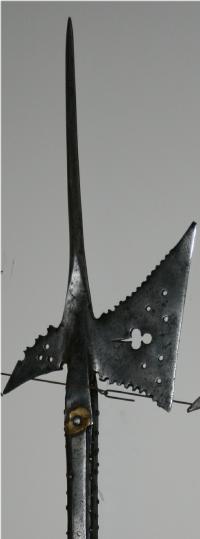
German Halbard mid 16th
diamond shaped spike. Long, straight blade and down-turned rear fluke. Top and bottom of the blade decorated with half-round notches. Top of fluke decorated with larger sem-circular notches. Fluke pierced with 3 holes. Blade pierced with 6 holes and a larger trefoil. 2 long original straps. Working life shaft with decorative studs. Ex Bischoff collection
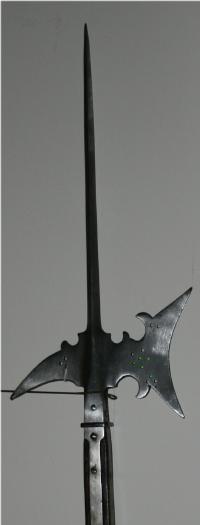
German Halbard late 16th
diamond shaped spike. curved blade. All 4 original straps. Original haft (shortened and restored). Ex Bischoff collection

German Halbard late 16th c.
very long diamond shaped spike. Concave half-moon shaped blade and down-curved rear fluke. Fluke and blade decorated with round piercings. 2 side straps forming part of the head and 2 additional straps covering the front and back of the shaft. Rectangular retaining ring at the base of the socket. Decorative washer on the top securing rivet in the head. App. half of the shaft is original, remainder a good replacement. Ex Bischoff Collection
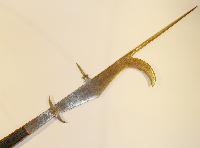
Italian Roncone late 16th
Pitted surface. Cleaned. Strong spike of square cross-section. Narrow rear spike also of square cross section. Blade decorated with incised crescents, curved marks and triangles between parallel lines from the base to the rear spike (rubbed). Marked with a trefoil formed of a tapered dash and 3 punch marks. All of the front edges sharpened (including both the inside and outside of the hook). Upper half of the rear edge also sharpened. Rectangular socket with short straps on the front and back sides. 28 1/2 inches long to the base of the socket. 5 inch straps.
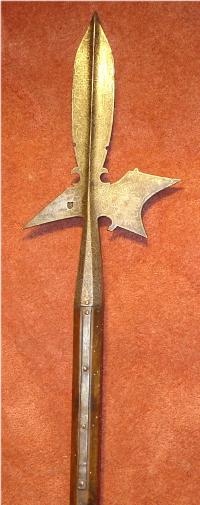
German Etched Halbard late 16th century
Leaf-shaped blade formed with a strong medial ridge, small axe-blade, rear fluke struck with a mark, faceted socket, and decorated over its full surface with strapwork interlace on a ground of spiral scrollwork. Patches of heavy wear, the haft and straps replaced.
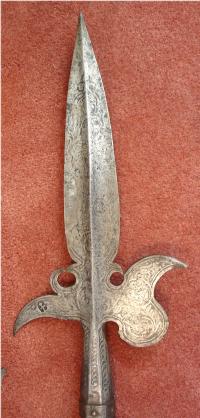
German Etched Halbard late 16th century
Leaf-shaped blade formed with a strong medial ridge, small S-shaped axe-blade, rear fluke struck with a mark, faceted socket, and decorated over its full surface with panels of scrolling foliage involving large flower-heads, the central blade decorated with soldiers in contemporary dress, the socket etched with the letters 'LZ'. Etching rubbed, haft replaced. Blade repaired.
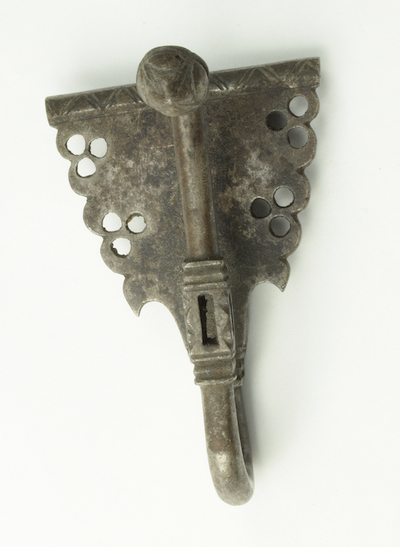
Sword hanger circa 1580-1620
Sword hanger. Polish/Hungarian. Base composing a belt loop. decorated with trefoil piercings and filed decoration at the edges. Hook incorporating a central square section pierced with rectangular slots. Tip of the hook swelled into a flower form. Brown patina with some wear.

Halbard circa 1590
diamond shaped spike. curved blade. 2 straps. Mark of Claus Lerchli - Kempten. Identified makers's marks are very rare on polearms. short shaft replaced.

Crossbow 16th century
Crossbow. Steel prod of heavy form. Tiller with swell at the prod and nut, tapering to the butt. Top of tiller overlayed with bone. Upper edge of the tiller decorated with alternating triangles of white and black-stained bone. Bone nut. Very nice early form.
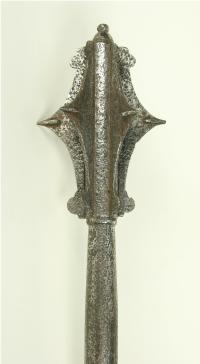
Mace 16th century
Entirely of steel, the head of six shaped flanges each extending to a reinforced point, button finial, tapering tubular haft pierced for a thong and cut with spiral lines at the grip, and rounded pommel with button terminal (heavily rust patinated overall) 62 cm.
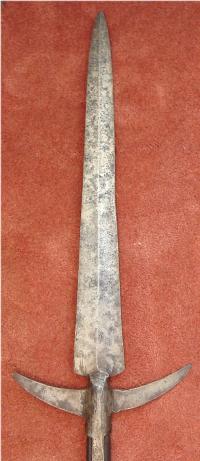
Military Spear 16th century
Military spear with long triangular blade, the socket applied with a pair of later lugs.

Partizan 16th/17th century
Partizan with long head with full-length ridge and small basal lugs.
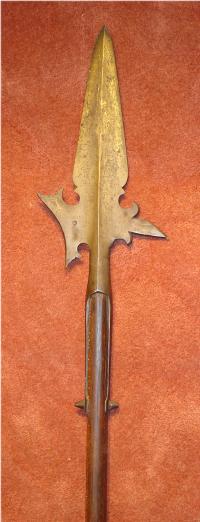
Halbard 16th/17th century
Military halbard of early regulation type.

Spear 16th/17th century
Military spear or leading staff with flat diamond-shaped small head on a slender socketed shank.

Leading-staff 16th/17th century
Leading-staff. Diamond shaped blade. Socket. On rounded later shaft.
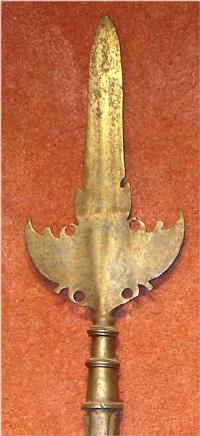
Partizan 16th/17th century
Small military partizan.

Italian Parade Halbard circa 1600
The head formed with a slender central spike encircled by a cage of moulded bars at the base, slender crescentric axe-blade, angular rear fluke, open socket extending to a pair of straps, and retaining traces of punched and engraved design. On its original octagonal shaft with remains of velvet at the top and small studs sprinkled along the shaft.

Halbard early 17th century
Probably German, the head incorporating a slender long spike, and the axe-blade and fluke each formed with a pair of recurved projections at the rear. Two straps covering part of the front and back of the haft. On a later round haft. Similar to item W-31.

Halbard early 17th century
Probably German, the head incorporating a slender long spike, and the axe-blade and fluke each formed with a pair of recurved projections at the rear. Two straps covering part of the front and back of the haft. On a later shaped haft. Similar to item W-30.
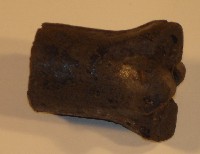
Lance tip 17th cent.
Lance tip. For the carousel jousts of the 17th century. Found in South Germany. Relatively small (app. 2 inches long) and seems to be cast.

Rapier 17th century
Rapier. Swept hilt. Long blade of diamond section. Tapered pommel. Wire wrap replaced.
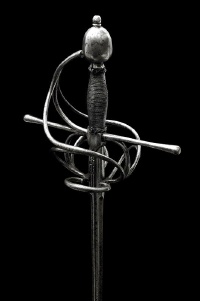
Rapier 17th century
Long diamond shaped blade with narrow fuller toward the hilt. Flat ricasso within the hilt. Hilt formed of tapered bars of rounded form. Oringinal wire grip with turk's head knots at each end. Pommel lightly faceted.
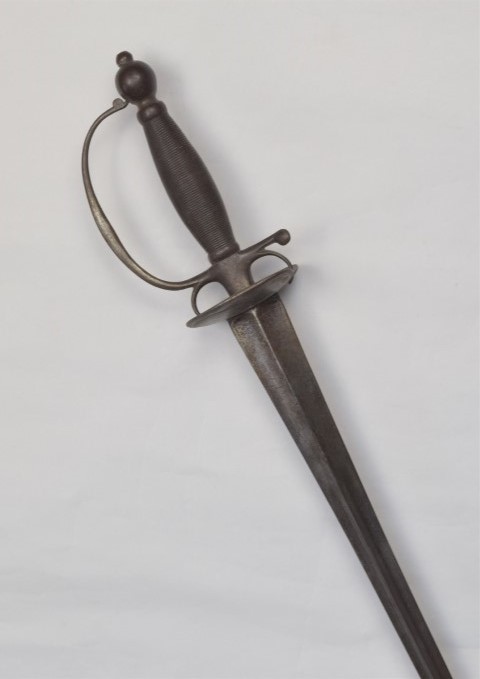
Small sword circa 1760
Small sword. Steel hilt. Wire-wrapped handle. Wide triangular blade. Inlaid roses (probably a mark) on the back of the blade.
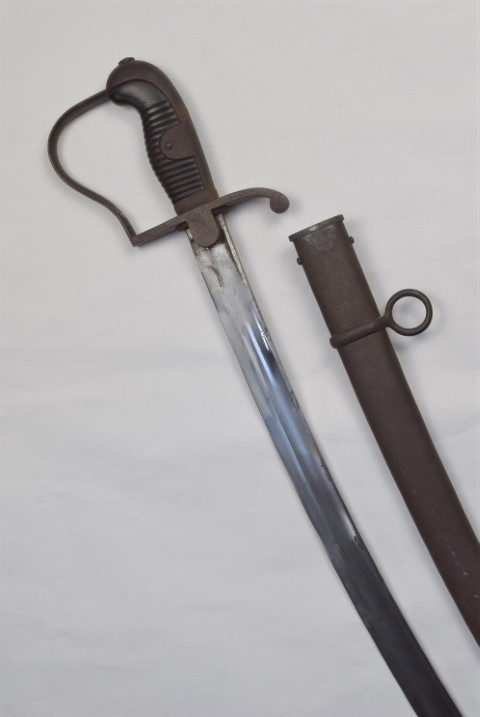
Saber 19th century
Saber. Iron loop hilt handle with integral pommel. Heavy curved single edged blade with a wide fuller and a short false edge at the back of the tip. Iron scabbard with suspension ring.
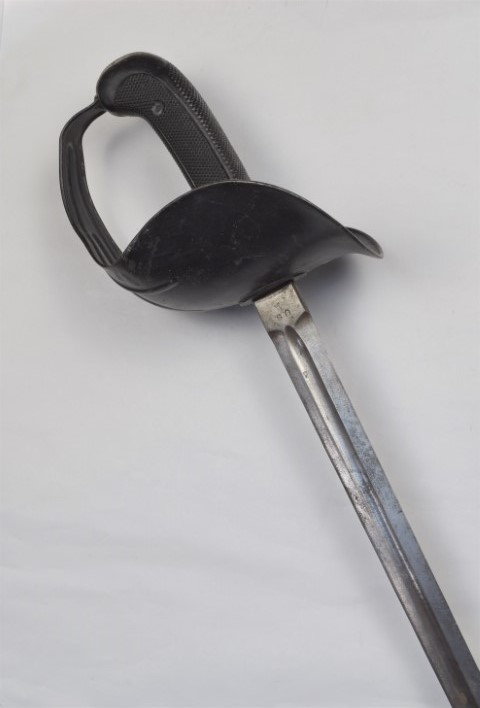
Saber 20th century
Saber. Iron bell hilt. Heavy straight double edged blade with a single fuller. Blade marked at the forte with L.F. and Co. 1918 on one side and U.S NO13 on the other. These can be seen in the images.

Italian Halbard 1st half 17th c.
long diamond shaped spike. Narrow half-moon shaped blade and down-turned fluke. Full socket extending to form 2 long straps inset into round shaft.
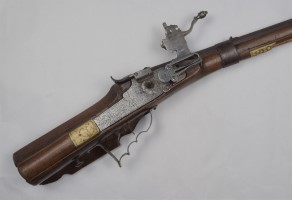
Wheellock Carbine early 18th century
German. Lock etched with a hunting scene. Lock with internal wheel, manual sliding cover. Stock inlaid with engraved bone. Barrel dated 1713.
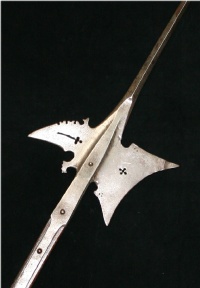
Halberd early-mid 16th century
Halbard. German or Swiss. Long spike of stiff diamond section, axe blade with slightly curved cutting-edge and pierced with a central quatre-foil and a triangular set of holes above and below. Fluke pierced with a trefoil with elongated stalk. . With decorative cusps on the fluke and some on the blade. Head terminates as 2 long straps secured to the sides of an old haft. Head 35 1/4 in. long from the point to the base of the socket.
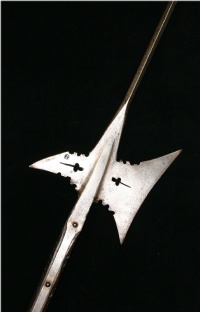
Halberd early-mid 16th century
Halbard. German or Swiss. Long spike of stiff diamond section, axe blade with slightly curved cutting-edge and pierced with a central quatrefoiland. fluke also pierced with a quatrefoil. With decorative cusps on the fluke and some on the blade. Head terminates as 2 long straps secured to the sides of an original haft. Stamped with an anchor on the fluke. Head 34 1/2 in. long from the point to the base of the socket.

Ballock Dagger Late 15th-early 16th century
Ballock dagger. Single edge blade with whittle tang. Pommel of dome form with terminal ball. straight handle and simple ballock-formed hilt with a flat bolster strike plate.
Measurements: overall length 10.5 in. (26 cm), blade length 5.25 in. (13.3 cm), blade thickness at the hilt .26 in. (.7 cm), blade width at the hilt 1.1 in. (2.8 cm) grip length butt to ballocks 3.25 in. (8.3 cm), grip diameter at the pommel .74 in. (19. cm) and .636 in. (1.6 cm) at the ballocks, pommel diameter 1.035 in. (2 cm), weight 4.1 oz (116.23 g).

Ballock Dagger Late 15th-early 16th century
Ballock dagger.
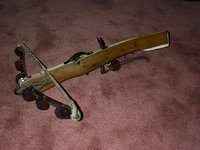
Crossbow Late 17th century
crossbow. Simple lines. Complete. Tassels replaced, but indicative of original form. Bone inlay to the upper surface. Stock 24 in. long, bow 20 in. long.